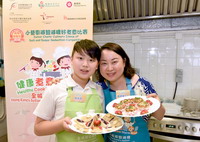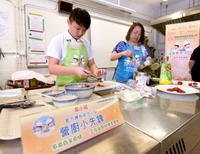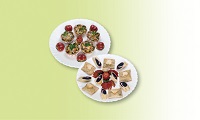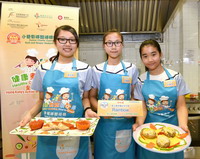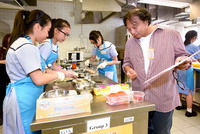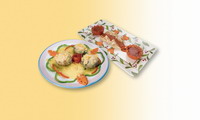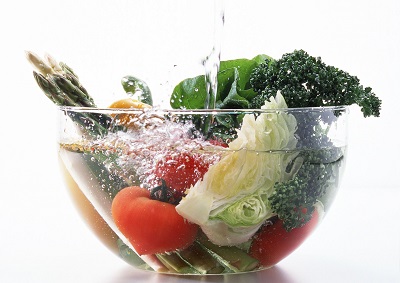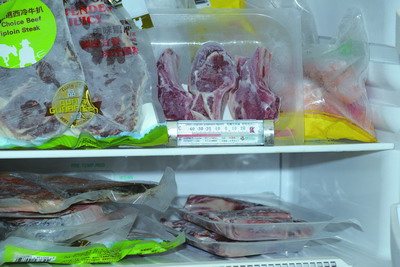
Food Safety Bulletin (3rd issue of 2016)
Feature Article
Food Safety Day 2016
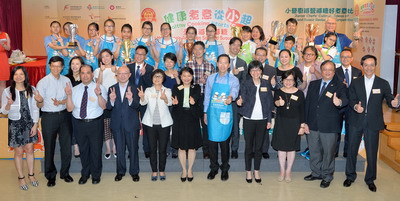
As the Chinese saying goes, "What one is like at eighty can be traced back to the age of three." Healthy habits are most effective when developed at a young age. That's why most parents encourage their children to make saving a habit early in life. In fact, health is the first wealth. It is also important to teach children to "accumulate wealth" in this regard.
We all know that eating habits and health are closely related. Excessive consumption of sodium and sugar may lead to chronic diseases. People with a high salt intake are at greater risk of developing hypertension, stroke and coronary heart diseases, whereas eating too much sugar increases the chance of obesity and dental caries. The Centre for Food Safety ("CFS") has been striving to safeguard food safety and promote healthy eating in Hong Kong. Starting last year, the CFS has been encouraging the public to build a healthy dietary habit with low intake of salt and sugar through publicity activities under the theme "Hong Kong's Action on Salt and Sugar Reduction".
The Food Safety Day is an annual signature event of the CFS to kick-start a series of promotional activities. Food Safety Day 2016 was held at the Arts and Technology Education Centre on 30 June 2016. The theme of this year's campaign is "Hong Kong's Action on Salt and Sugar Reduction: Healthy Cooking Starts Small". The meaning of "small" is two-folded, as healthy cooking begins not only with small actions but also with small children.
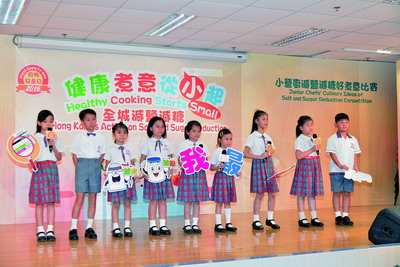
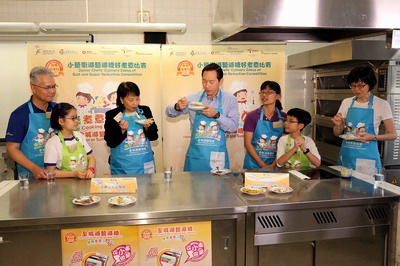
Officiating guests at the event included Mrs Cherry TSE, Permanent Secretary for Food and Health (Food); Miss Vivian LAU, Director of Food and Environmental Hygiene; Dr HO Yuk-yin, Acting Controller of the CFS; Dr MAK Sin-ping, Vice-chairperson of the Committee on Reduction of Salt and Sugar in Food ("CRSS"); Mr CHENG Wing-cheung, Chief Curriculum Development Officer (Technology Education) of the Education Bureau ("EDB"); Dr Christopher LEUNG, Vice-principal of the Chinese Culinary Institute ("CCI"); and Ms YUNG Pik-ching, Secretary of the Committee on Home-School Co-operation ("CHSC"). Signatories of the Food Safety Charter ("FSC") were invited to attend the ceremony in recognition of their continuous support for promoting food safety and healthy diets. A signing ceremony was also held during which representatives from food trade associations signing up for the FSC and the "Reduce Salt, Sugar, Oil. We Do!" Programme pledged to take appropriate measures to enhance protection of food safety and serve customers with healthy food prepared with less salt, sugar and oil.
The highlight of the day was the final adjudication and award presentation ceremony of the "Junior Chefs' Culinary Ideas of Salt and Sugar Reduction Competition". The competition was jointly organised by the Food and Environmental Hygiene Department ("FEHD"), the CFS and the EDB, with the CRSS, the CCI and the CHSC as supporting organisations. It was the first of its kind to explore healthy and tasty culinary ideas and encourage the application of food safety tips when preparing food, with a view to fostering healthy eating and food safety habits.
The competition consisted of senior primary (parent-child teams) and junior secondary categories. With "salt and sugar reduction" as the theme, entrants could either design a novel recipe low in salt and sugar or modify traditional recipes using less salt and sugar. Of course, "food safety" and "tastefulness" were the key factors not to be neglected. There was an enthusiastic response with 65 presentations on recipes received by the CFS. In the first round, six finalist teams were shortlisted from each category. Their recipes were uploaded to the competition website for public voting. The presentation with the highest number of votes in each category was the winner of the "Most Liked Award".
On the day of final adjudication, the "junior chefs" displayed their cooking skills and gave an outstanding performance. The finalists presented their novel recipes with low salt and sugar content and demonstrated on site their dishes to bring out the message that creativity could add flavour to food prepared with reduced salt and sugar. Each dish was tasted and given a score by the judging panel, which then selected the champion and the first and second runner-ups of each category.
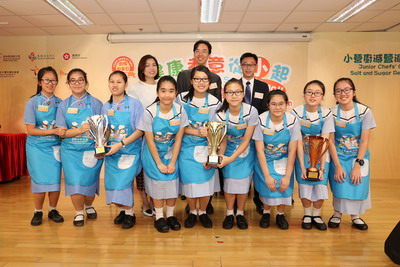
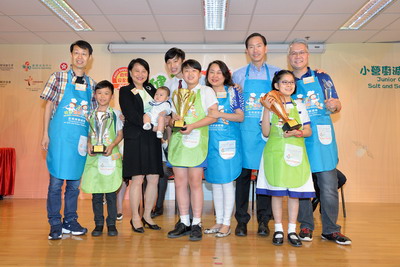
Mr Bernard Chan, Chairperson of the CRSS, officiated at the award presentation ceremony of the competition to present prizes and certificates to the winning teams and share his cooking ideas with the participating students and parents.
We would like to take this opportunity to extend our congratulations to all the winning teams. The prize winners and their marvelous dishes are listed below:
Senior Primary Category (Parent-child Teams)
| Winning Teams | Prize Winning Snacks | |
|---|---|---|
| Champion |
St. Francis of Assisi's English Primary School ─ 營廚小先鋒
|
Multi-veggie Tuna Tarts
|
| First runner-up |
Ying Wa Primary School ─ 英華營廚 |
Crabmeat and Tomato Salad |
| Second runner-up |
Diocesan Girls' Junior School ─ Father-daughter Sure-win Team |
Mini Apple Cups |
| Most Liked Award |
Diocesan Girls' Junior School ─ Father-daughter Sure-win Team |
Mini Apple Cups |
Junior Secondary Category
| Winning Teams | Prize Winning Main Dishes | |
|---|---|---|
| Champion |
SKH Lam Woo Memorial Secondary School ─ Rainbow
|
Pan-fried and Veggie-stuffed Minced Chicken Cakes
|
| First runner-up |
Maryknoll Fathers' School ─ " 董 " 煮意 |
Pumpkin Risotto with Shrimps |
| Second runner-up |
SKH Lam Woo Memorial Secondary School ─ 營養星廚 |
Shrimp Balls Stuffed with Pumpkin and Quinoa |
| Most Liked Award |
Kwai Chung Methodist College ─ KCMC Little Chefs |
Steamed Shrimp Balls |
Following the Food Safety Day 2016 opening ceremony, a series of publicity initiatives on food safety and healthy eating are being launched. The CFS hopes that the goal of reducing salt and sugar intake by the local population will be achieved through tripartite collaboration among the government, the public and the food trade so that everyone can enjoy a healthy lifestyle.
Readers' Corner
Safety Tips to Reduce Pesticides in Vegetables and Fruits
What Is a Pesticide?
A pesticide is any substance or mixture of substances intended for preventing, destroying, repelling or mitigating pests. Classes of pesticides commonly used for crop growing include:
- Insecticides (to control insect infestations)
- Fungicides (to control the spread of fungal diseases)
- Herbicides (to control the competing effects of weeds)
Why Would Vegetables and Fruits Contain Excessive Pesticide Residues?
When used properly, pesticides can improve the quantity and quality of food as well as reducing the chance of crops being eaten up and damaged by pests. However, the use of pesticides in food production would inevitably leave residues in some of the products. If the trade does not observe Good Agricultural Practice when applying pesticides, such as overusing pesticides on crops and not allowing sufficient time for pesticides to decompose before harvesting, the crops may contain excessive pesticide residues.
How Are Pesticide Residues in Food Being Regulated?
Through its Food Surveillance Programme, the CFS regularly takes vegetable samples at the import, wholesale and retail levels for testing of pesticide residues in the Government Laboratory. The CFS will determine whether the pesticide residue levels in vegetables are in excess of the limits prescribed by the Pesticide Residues in Food Regulation (Cap. 132CM) in order to safeguard public health.
What Can the Public Do to Minimise Dietary Exposure to Excessive Pesticide Residues from Vegetables and Fruits?
- Purchase vegetables and fruits from reliable sources.
- When handling vegetables, wash the m thoroughly under clean running water several times, or blanch them in boiling water for a minute and discard the water used.
- When handling fruits, rub the peels under clean running water.
- For further reduction of pesticide residues on vegetables and fruits, we can remove the outer leaves of vegetables or peel the fruits.
- Maintain a balanced diet and eat a variety of vegetables and fruits to avoid excessive exposure to pesticides from a small range of vegetables and fruits.
Get the Temperature Right
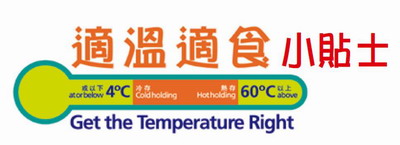
Improper storage temperatures for food would facilitate bacterial growth and increase the risk of food poisoning. Preferably, food should be consumed immediately after preparation. Otherwise, food should be held hot or kept refrigerated at a suitable temperature.
- Store cold food at or below 4°C
- Keep hot food at 60°C or above.
Placing a thermometer in a refrigerator or a hot food holding cabinet can help monitor and ensure proper storage temperatures for food.
News on New Dishes
Safety Tips on Preparing "Pan-seared Salmon with Sautéed Assorted Vegetables"
When talking about salmon, most of us will prefer eating it raw as the fish meat is fleshy and tender. Have you thought of other salmon recipes? Pan-seared salmon is in fact a good option. It is not only simple and quick to prepare but also very delicious. You might as well have a try. This time , we have invited the chef of " California Pizza Kitchen", a signatory of the Food Safety Charter , to demonstrate the preparation of the dish "Pan-seared Salmon with Sautéed Assorted Vegetables " for us.

| Preparation Steps | Small Tips, Big Wisdom | |
|---|---|---|
Receiving  |
Purchase ingredients from approved and reliable suppliers. | Upon receipt of the ingredients, check carefully to ensure their freshness. Keep vegetables in a refrigerator at 4ºC or below and the frozen salmon fillet at -18ºC or below . |
Thawing  |
Thaw the salmon fillet in a refrigerator at 4ºC or below . | Thawing the fillet in a refrigerator at 4ºC or below can effectively prevent bacterial growth and enable the fish meat to regain its original tenderness . |
Rinsing 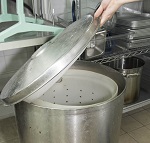 |
Rinse all vegetables thoroughly using a vegetable washer. | Rinsing vegetables with clean water can effectively reduce the risk of pesticide intake and remove surface impurities such as sand and mud. |
Cutting  |
Shred/dice the onion, tri-colour bell peppers, carrots, broccoli (blanched), string beans (baked), white mushrooms and Welsh onions. | Vegetables that require a longer cooking time should be blanched or baked beforehand. The ingredients should also be shredded or diced. These steps can shorten the time of subsequent high-temperature cooking and prevent the formation of harmful substances |
Pan-searing  |
Drain the salmon fillet well. Sprinkle herbal seasoning over the back side of the fillet. Heat olive oil in a pan over high heat . Put in the salmon fillet, then turn to medium heat. Cover the pan lid and cook each side of the fillet for 4 minutes until the fish meat turns golden yellow. Soak up excess oil with an oil-absorbing cooking paper. Dish up and set aside. |
The pan-seared salmon fillet should be consumed as soon as possible. Avoid leaving it at room temperature for more than 2 hours. |
Sautéing  |
Heat canola oil in wok over high heat. Add assorted vegetables, a pinch of salt and black pepper powder and sauté for 2 minutes. Lastly, pile the vegetables beside the salmon on the plate. Garnish with a lemon wedge and ready to serve. | Sautéing in wok can enhance the taste of ingredients and ensure that they are thoroughly cooked. |

Tips from Mr IP Ka-chun, General Manager of California Pizza Kitchen:
- Olive oil is used for pan-searing the salmon fillet garnished with assorted vegetables. Hence the dish is highly nutritious, delicious and commensurate with healthy eating.
- When pan-searing the salmon fillet, cover the pan with a lid. Cook one side until done, then turn and cook the other side. This can ensure that the fillet is thoroughly cooked and its natural flavour is preserved.
- California Pizza Kitchen attaches great importance to food safety. It lays down a monitoring system with codes of hygiene practices and operational guidelines and on-the-job training for employees to ensure that food hygiene and quality meet the strict standards set by the restaurant group. Moreover, food ingredients are ordered from reliable suppliers in quantities based on daily requirements. Dishes are also made to order so that the ingredients remain fresh and the food is safe for consumption.
- Refrigerators are checked and their temperatures are recorded every day to ascertain storage of food or ingredients at safe temperatures. In case any irregularities (e.g. odours) are found, the food or ingredients concerned will be discarded immediately.
Food Safety Plan Corner
Pan-seared Salmon with Sautéed Assorted Vegetables
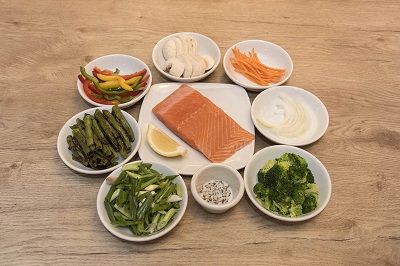
Ingredients:
Salmon fillet, onion, tri-colour bell peppers, carrots, broccoli, string beans, white mushrooms and Welsh onions
Seasonings:
Black pepper powder, herbal seasoning and lemon
Steps:
- Thaw the frozen salmon fillet (stored at -18°C) in a refrigerator at 4°C or below.
- Rinse the vegetables stored at 4°C or below thoroughly. Use a vegetable washer and clean water.
- Blanch the broccoli and bake the string beans beforehand.
- Shred/dice the onion, tri-colour bell peppers, carrots, broccoli (blanched), string beans (baked), white mushrooms and Welsh onions.
- Drain the salmon fillet well. Sprinkle herbal seasoning over the back side of the fillet.
- Heat olive oil in a pan over high heat. Put in the salmon fillet, then turn to medium heat. Cover the pan lid and cook each side of the fillet for 4 minutes until the fish meat turns golden yellow. Soak up excess oil with an oil-absorbing cooking paper. Dish up and set aside.
- Heat canola oil in wok over high heat. Add assorted vegetables, a pinch of salt and black pepper powder and sauté for 2 minutes. Lastly, pile the vegetables beside the salmon on the plate. Garnish with a lemon wedge and ready to serve.
Production Process
Briefing of Activities
Centre for Food Safety Facebook Page
To most people in Hong Kong, browsing Facebook is a part of daily routine. Now with the CFS Facebook page, not only can you follow status updates of friends and share moments of your life on Facebook, you can also obtain information from the CFS, including food alerts, food safety reports, food safety tips, results of theme studies and CFS publications. Announcements in the public interest on food safety, highlights of its activities and information on food safety seminars and workshops will be uploaded to this page to keep users posted. You are welcome to give "likes" and share your views on the CFS Facebook page.
In view of the community concern about reducing sugar and salt in food, the CFS has set up a dedicated Facebook page on Hong Kong's Action on Salt and Sugar Reduction to keep the public updated with the related initiatives. The page provides a wide range of information, including the health risks of excessive consumption of salt and sugar, relevant health risk assessments and studies, as well as practical tips on reduction of dietary intake of salt and sugar. People who pay attention to health and food issues should not miss it.
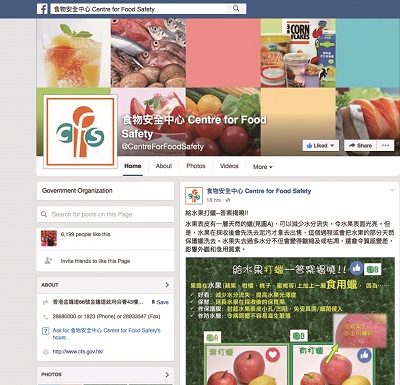

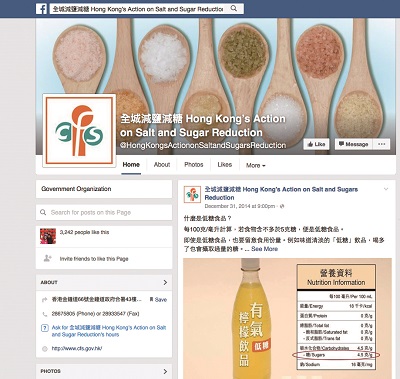

"Food Safety App"
Do you want to learn more about food safety? With your mobile devices, you can view and receive food alerts and food safety updates released by the CFS, search for information and advice on food safety, download food safety publications, set up archives and read articles on various food safety topics, anytime and anywhere. For a handy guide to safe and healthy diets, download the "Food Safety App" now!

Android version & iPhone version
Upcoming Activities
Thematic Exhibitions of Communication Resource Unit
In the previous issue, we introduced to you the Communication Resource Unit ("CRU") of the CFS in Mong Kok. Have you been there? The CRU regularly holds exhibitions on food themes of public concern. These include safe handling of food, such as "5 Keys to Food Safety", "Avoid Contact Between Raw and Cooked Foods to Prevent Cross-contamination" and "Ten Golden Rules for Safe Food Preparation". There is also information about particular types of food, such as "Why Should We Avoid Consuming Puffer Fish", "Avoid Exposure to Harmful Contaminants When Eating Scallops" and "How to Process Food Plants with Natural Toxins". In addition, tips are offered to people who need to pay special attention to food safety, such as "Food Safety Advice for Pregnant Women" and "Food Safety Advice for Travellers". Announcements will be posted on the CFS website from time to time. Stay tuned and do not miss any topics that may interest you.
The CRU mounts roving exhibitions on food safety at different venues, such as major shopping centres in public and private housing estates, public markets and government offices across the territory. The exhibition boards are also displayed at the Health Education Exhibition and Resource Centre of the FEHD in Kowloon Park, Tsim Sha Tsui. All visitors are welcome to take a look at them. The CRU, moreover, provides free exhibition panel loan out service to facilitate different sectors of the community in organising activities to promote food safety.
The following are the two most popular exhibition panels on display: "Nutrition Label 101" and "Control Food Temperature Properly 4 to 60 Degrees is Risky".
| Nutrition Label 101 | |
|---|---|
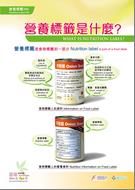 |
Key points:
|
| Control Food Temperature Properly 4 to 60 Degrees is Risky | |
|---|---|
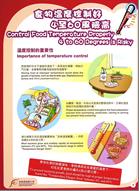 |
Key points:
|
Food Safety Q&A
Are "Milk" and "Milk Beverages" Different?
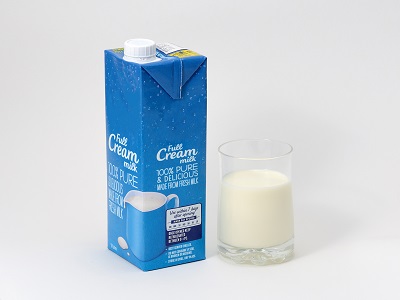
Milk or Milk Beverages?
"Milk" and "milk beverages" are commonly consumed drinks. How are they different from each other?
The Food and Drugs (Composition and Labelling) Regulations (Cap. 132W) provide that:
- Milk shall contain not less than 3.25% of milk fat, and the quantity of milk solids shall not be less than 8.5%.
- A milk beverage shall contain not less than 0.1% of milk fat.
As for skimmed milk which we quite often drink, it shall contain not more than 0.3% of milk fat, and the quantity of milk solids shall not be less than 8.5%.
Moreover, when a nutrient content claim is made on the packaging of a food product, the components listed must satisfy the conditions stipulated by law. For example, a "high calcium" claim may be made when the amount of calcium is more than 120 mg per 100 mL of liquid food, and a product can be claimed as "low fat" if it contains not more than 1.5 g of total fat per 100 mL of liquid food.
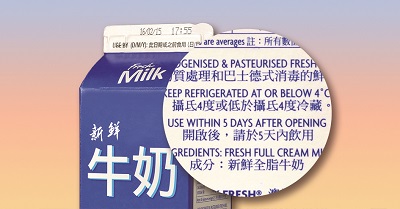
Pasteurisation or Sterilisation?
Raw milk needs to be heat-treated due to possible contamination with pathogenic or food spoilage microorganisms. "Pasteurisation" and "sterilisation" are two commonly-used heat treatment methods. Do you know their differences?
- Pasteurisation is a relatively mild heat treatment usually performed below 100°C to reduce harmful microorganisms in food. It does not significantly affect the nutritional quality and taste of food. Since pasteurisation does not kill all microorganisms, pasteruised milk should be refrigerated at or below 4˚C.
- Sterilisation is a more severe heat treatment to destroy all microorganisms capable of growing in food under normal conditions of storage. It may affect the nutritional and sensory qualities of food. Milk having received ultra-high temperature ("UHT") treatment can be stored at room temperature as long as it is sealed.
"Use by" Date or "Best before" Date?
In the market, some milk beverages have a "use by" date on the packaging while others are marked with a "best before" date. What are their differences?
- "Use by" dates refer to food safety and are used for foods which, from the microbiological point of view, are highly perishable and are therefore likely after a short period to constitute an immediate danger to health. For instance, pasteurised milk only has a short shelf life. Drinking expired milk can lead to an imminent health hazard. Such kind of food should be marked with a "use by" date.
- "Best before" dates are related to the quality of food, its taste, texture, aroma and appearance. They give you an idea how long foods should reasonably be expected to retain their specific properties if stored properly. "Best before" dates generally apply to foods that do not contain and/or support the growth of food poisoning bacteria, foods that require cooking or other processing steps to reduce or eliminate food poisoning bacteria before consumption, as well as foods that are likely to show obvious signs of spoilage before posing a food safety risk to the consumer. For example, UHT-treated milk beverages have a longer shelf life and can be stored in sealed containers without refrigeration for months. They are often labelled with "best before" dates.
Advice to the Public
- In Hong Kong, the Food and Drugs (Composition and Labelling) Regulations set out specific standards and controls on the composition and labelling of milk and milk products. Members of the public should check the food label (including food name and ingredient list) carefully to make informed food choices according to personal needs.
- Different heat treatments may have different effects on the nutritional value and taste of food. When purchasing milk or milk products, it is advisable to read the heat treatment description on the packaging.
- Members of the public should note the expiry date on the food label in food buying and consumption. We should not purchase and consume foods after their "use by" dates. For foods which "best before" dates have expired, we should pay attention to their quality.
Truth against Fallacy
Why Unpeeled and Sprouted Potatoes Are Unfit for Human Consumption?

| Ming: | I bought a lot of potatoes earlier during a big sale. Now they have all sprouted. Today, I am going to prepare a potato feast to clear the stock. First, we will have potato fruit salad as the appetizer. Then comes a tomato potato soup. The main course will be baked potatoes with broccoli and cheese, braised chicken wings with potatoes, etc. Any other good suggestions? |
| Pat: | My suggestion is not to eat these potatoes! Sprouting potatoes may contain high levels of glycoalkaloids, which are natural toxins that may be present in plants of the Solanacea family to help guard against insect or animal predators. The levels of glycoalkaloids in fresh potatoes are usually low. In normal tubers, glycoalkaloids are concentrated in a thin layer of 1.5 mm immediately under the peel. Hence, with normal tubers, peeling of potatoes can greatly reduce the levels of the toxins. No adverse health effects will occur. However, the levels of glycoalkaloids may be very high in potatoes that show signs of greening, physical damage or rotting, especially in the parts that have developed sprouts. |
| Ming: | What will happen if these potatoes are eaten? |
| Pat: | Potatoes containing excessive glycoalkaloids taste bitter. If we consume them, we will have a burning sensation in our throats and mouths. Acute symptoms including nausea, vomiting, stomach and abdominal cramps and diarrhea will generally occur 30 minutes to 12 hours after ingestion. More severe cases of glycoalkaloid poisoning may be accompanied by a variety of neurological effects, such as drowsiness, restlessness, shaking, confusion, weakness and disturbed vision. |
| Ming: | If I cut away the sprouts or cook the potatoes more thoroughly, will that be OK? |
| Pat: |
For slightly sprouted potatoes, you can cut away the parts that show signs of damage (cuts and bruises), rotting, greening and sprouting before cooking. But in severe cases, you should discard the entire potato. Glycoalkaloids are highly heat resistant. High-temperature cooking does not destroy these toxins or reduce their amount in potatoes. As I see it, you are having seriously sprouted potatoes. You'd better not take the risk. Throw away the potatoes at once. |
| Ming: | Alright. |
Brain Gym
Card Game
Get to Know "1+7": The Seven Specified Nutrients
On nutrition labels, "1+7" refers to energy plus seven specified nutrients. Do you remember the seven nutrients? Let's play the following game.
Rules: Cut out the playing cards and lay them out face down. Players take turns to flip over two cards at one time to find a match. Only cards showing the same nutrient of any of the seven nutrients specified for labelling "1+7" form a matching pair. When two cards do not match, they are turned back over and returned to their original positions. The game ends when cards indicating the seven nutrients are all found in pairs. The player with the largest number of pairs wins the game.
|
Sugars |
Total fat |
Vitamin C |
Calcium |
Trans fat |
Protein |
|
Polyunsaturated |
Folic acid |
Saturated fat |
Sugars |
Dietary fibre |
Carbohydrates |
|
Sodium |
Trans fat |
Vitamin K |
Saturated fat |
Sodium |
Omega-3 fatty acids |
|
Cholesterol |
Carbohydrates |
Amino acids |
Total fat |
Zinc |
Protein |
Answers :
The seven specified nutrients on a nutrition label are:
Protein, total fat, saturated fat, trans fat, carbohydrates, sugars and sodium
Enquiries and Subscription
Printed copies of the Food Safety Bulletin can be obtained from the CRU at 8/F, Fa Yuen Street Municipal Services Building, 123A Fa Yuen Street, Mong Kok, Kowloon. For enquiries, please call 2381 6096. The public may also visit the CFS website ( www.cfs.gov.hk ) for the online version.
| Enquiry hotline | 2868 0000 |
|---|---|
| E-mail address | enquiries@fehd.gov.hk |
| CFS website | www.cfs.gov.hk |
